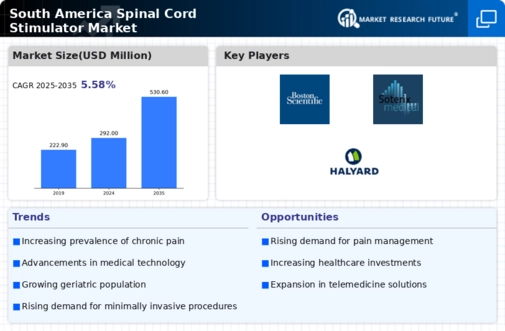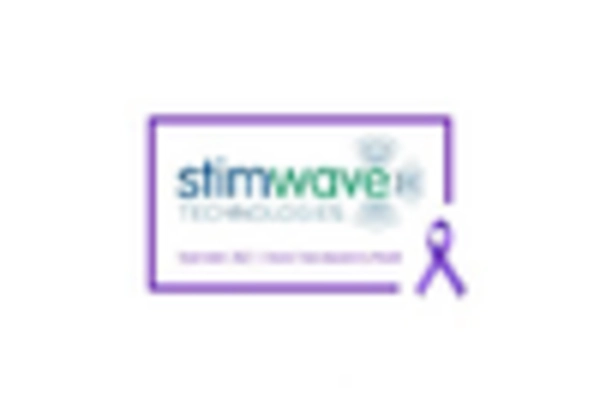Growing Geriatric Population
The demographic shift towards an aging population in South America is a significant driver for the spinal cord-stimulator market. As individuals age, they are more susceptible to chronic pain conditions and neurological disorders, which often necessitate advanced treatment options. By 2030, it is estimated that the proportion of individuals aged 65 and older in South America will increase to over 15%, leading to a higher demand for effective pain management solutions. Spinal cord stimulators provide a minimally invasive option for managing pain, making them particularly appealing to older patients who may have comorbidities. This demographic trend suggests a sustained increase in the adoption of spinal cord stimulators, thereby contributing to the overall growth of the market in the region.
Rising Incidence of Chronic Pain
The increasing prevalence of chronic pain conditions in South America is a primary driver for the spinal cord-stimulator market. Conditions such as neuropathic pain, fibromyalgia, and failed back surgery syndrome are becoming more common, affecting millions. According to recent health statistics, approximately 30% of the population in certain South American countries report chronic pain, which necessitates effective management solutions. Spinal cord stimulators offer a promising alternative to traditional pain management methods, such as opioids, which have been associated with significant side effects and dependency issues. As healthcare providers seek innovative treatments, the demand for spinal cord stimulators is likely to rise, thereby propelling market growth. This trend indicates a shift towards more advanced pain management strategies, positioning the spinal cord-stimulator market as a critical component in addressing chronic pain in the region.
Advancements in Medical Technology
Technological innovations in medical devices are significantly influencing the spinal cord-stimulator market in South America. Recent developments in neurostimulation technology, including improved electrode designs and wireless capabilities, enhance the efficacy and patient experience of spinal cord stimulators. These advancements allow for more precise targeting of pain pathways, leading to better outcomes for patients. Furthermore, the integration of smart technology enables real-time monitoring and adjustments, which can optimize treatment plans. The market for spinal cord stimulators is projected to grow at a CAGR of around 10% over the next five years, driven by these technological enhancements. As healthcare systems in South America increasingly adopt advanced medical technologies, the spinal cord-stimulator market is poised for substantial growth, reflecting a broader trend towards innovation in pain management.
Increased Investment in Healthcare Infrastructure
The ongoing investment in healthcare infrastructure across South America is fostering growth in the spinal cord-stimulator market. Governments and private entities are allocating resources to enhance healthcare facilities, improve access to advanced medical technologies, and train healthcare professionals. This investment is crucial for the implementation of spinal cord stimulation therapies, as it ensures that hospitals and clinics are equipped with the necessary tools and expertise. For instance, Brazil and Argentina have seen substantial increases in healthcare spending, with projections indicating a rise of 5-7% annually. As healthcare systems evolve and expand, the availability of spinal cord stimulators is likely to increase, thereby driving market growth and improving patient outcomes.
Rising Awareness of Alternative Pain Management Solutions
There is a growing awareness among patients and healthcare providers in South America regarding alternative pain management solutions, which is positively impacting the spinal cord-stimulator market. As the limitations and risks associated with traditional pain medications become more apparent, patients are increasingly seeking innovative therapies. Educational campaigns and outreach programs are helping to inform both patients and healthcare professionals about the benefits of spinal cord stimulators. This shift in perception is reflected in the rising number of consultations for spinal cord stimulation therapy, which has increased by approximately 20% in recent years. As awareness continues to grow, the demand for spinal cord stimulators is expected to rise, further solidifying their role in the pain management landscape of South America.


















Leave a Comment